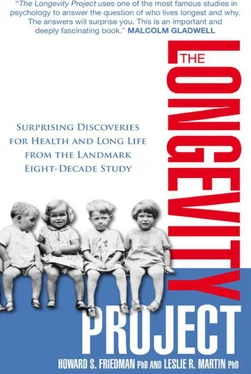These potential suicide predictors were then used in a statistical procedure called discriminant function analysis. The Internal Revenue Service uses discriminant function analysis to predict whether you may be a tax cheat, based on various elements of your tax return as well as previous knowledge of past cheaters. In the case of Terman suicides, this type of analysis is used to measure which elements of one’s history and pathway may predict willingness to cheat life.
The signatures of suicidal mental health did an impressive job of predicting whether someone would commit suicide, have an early natural death, or live a long life. In addition, high levels of stress and a moody, impulsive temperament contributed to the risk.
Most interesting, however, was that individual characteristics, things about the social environment, and challenges relevant to stress all contributed to suicide risk. It wasn’t just anxiety and depression, it wasn’t just alcoholism, it wasn’t just early life stress, and it wasn’t just instability in relationships and careers. All of these things mattered—a person’s overall pathway influenced the likelihood of suicide.
Many Terman subjects, for example, were anxious or faced serious challenges but lived long lives. It was those who ignored the guideposts to good health who were most at risk—they traveled down pathways that became more and more dangerous, and eventually fatal. On the other hand, those who circled back to the healthy road often went on to a long life.
Terman Men Who Shot Themselves
The late suicidologist Dr. Shneidman did not think too highly of blaming suicide on a chemical imbalance in the brain. He knew that suicide was related to deeper issues surrounding the meaning of life and death, and he knew that suicide rates varied greatly across cultures, times, and circumstances. He concluded that it couldn’t be fully understood as a brain disease, nor fully prevented with antidepressant drugs. He did not use the term catastrophizing, but he knew and agreed that the ways people thought about the world were keys to understanding suicide.
One day Dr. Shneidman called us; he started to identify himself, but we knew who he was. We knew that in addition to his other groundbreaking work, Shneidman had studied the lives of five Terman men who had shot themselves while still in their forties or fifties. 29 29 To read more about Dr. Shneidman’s investigation into the lives of these men who shot themselves, see E. Shneidman, “Perturbation and Lethality as Precursors of Suicide in a Gifted Group,” Life-Threatening Behavior 1 (1971): 23-45. See also Shneidman’s book The Suicidal Mind (New York: Oxford University Press, 1998).
As with the study of Terman women, this project also used two control groups—men who died at comparable ages from illness, and men who lived long lives. In a clever research move, Dr. Shneidman had an assistant prepare detailed biographies of each of the men, from childhood through about age thirty, but with all information about the man’s subsequent longevity removed. (For example, in one prepared biography, a high school counselor had written that the young man was emotionally unstable and morally erratic, while a Terman staffer who had visited the same subject described more details and reported that he was quite likable.) Shneidman then carefully read the materials in each man’s folder, without knowing which group the man was in, that is, without seeing his eventual fate. Unbeknownst to Shneidman, five were suicides by gunshot, ten were natural deaths at a comparable age, and fifteen were men still living.
Dr. Shneidman evaluated each of these Terman participants on two dimensions. The first was one he called “perturbation,” a measure of the person’s level of agitation, disturbance, and lack of composure. This measure included a focus on the man’s early relationships with his parents; his level of life success or failure; and the presence of the markers of poor mental health, such as alcoholism, depression, and instability.
Shneidman’s second dimension was something he called “lethality,” which included features of the man’s life that reflected his likely intentions about his death. This could be recent anticipations of trouble, thoughts or premonitions of accidents or death, or disappointments with accomplishments. (One of the Terman subjects, for example, reported at age twenty-nine that he now believed that his early intellectual gifts had been merely a flash in the pan.) After reviewing the prepared biographies, and evaluating perturbation and lethality, Shneidman used his clinical judgment to rank the thirty men included in his analysis in order of the likelihood of their suicide.
Dr. Shneidman’s accuracy was striking. His rankings placed all five of the actual suicides in his top six most likely suicides. He was not using numeric data put through a discriminant analysis, as was done in the study of female Terman suicides, but his clinical judgments were correct. He was able to capture those aspects of the men’s lives that foretold their later suicide.
The men who shot themselves thought that something important was missing in their lives. They drew from that a bigger conclusion—that their lives were not worth living. In addition to their unstable lives, their disappointment in their achievements—the discrepancy between what they aspired to do and what they actually accomplished—weighed very heavily on these men, and they believed all was lost. These beliefs are very similar to the catastrophizing that our studies have shown to correlate more broadly with early death from violent causes.
By the way, it is interesting to note that when Dr. Shneidman was not studying suicide, he was studying the novels and essays of the dark romance novelist Herman Melville. He especially loved Moby-Dick . Whenever the protagonist in Moby-Dick feels a damp, drizzly November in his soul and involuntarily pauses before coffin warehouses, it is high time to get to sea as soon as he can. But in real life, Melville’s own son Malcolm shot himself and died. Shneidman, Melville, and Douglas Kelley shared a fascination with the deeper existential issues of catastrophizing thoughts.
The reason Ed Shneidman had telephoned us was that he had learned of our ongoing work with the Terman participants, and he wanted to send us the audiotapes of the in-depth interviews he had conducted with Terman men late in life—in the 1980s—when both he and the subjects were over age seventy. Dr. Shneidman was living in Los Angeles, as were forty-five of the Terman men. He saw the men every year or so through 1987 (about seven years), mostly asking them about their lives. One particularly fascinating report he wrote focused on eleven of these Terman men who were lawyers (or retired lawyers).
Shneidman transcribed all the interview responses of these eleven participants, across fifty-one interview sessions and 241,985 words. He analyzed the frequencies of all the words they used in their responses to his open-ended questions. He felt their vocabulary would provide some insight into how these aging men thought about their lives.
The men who were in this group were generally successful and relatively healthy for their age. Most were still working (at least part-time) into their seventies and early eighties. We knew that catastrophizing tended to predict who would die prematurely, but what thought style was predominant among those who aged successfully?
Perhaps not surprisingly, these older men, who were still able and eager to contribute to society, willing to participate in Shneidman’s interviews, and capable of reflecting on their lives, did not sound like catatastrophizers at all. The most prominent conversation topics—based both on the number of different words used and on the total number of occurrences of words related to that topic—were occupation, family, and health.
Читать дальше











